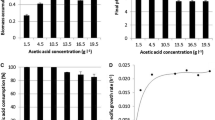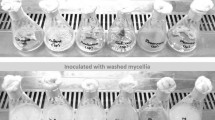Summary
Glucose and cellobiose are the principle sugars released during cellulose hydrolysis. The utilization of mixtures of these sugars (10 g·l−1) by Candiada wickerhamii in batch cultures under aerobic and non-aerated conditions was investigated. Glucose was utilized first followed by cellobiose after a diauxic lag. Ethanol was produced from glucose under both aerobic and non-aerated conditions. Following glucose depletion under aerobic conditions, ethanol (produced during growth on glucose) and cellobiose were utilized simultaneously. Under non-aerated conditions ethanol was produced from cellobiose after the diauxic lag. When the glucose concentration was increased from 2 to 8 g·l−1 in glucose: cellobiose mixtures (total sugar 10 g·l−1), decreases of 66–91% were observed in the specific rates of growth, ethanol production, β-glucosidase production and sugar utilization on cellobiose as well as an increase in the diauxic time lag under aerobic and non-aerated conditions. After depletion of glucose, the viability of C. wickerhamii decreased during cellobiose utilization.
Similar content being viewed by others
Abbreviations
- E:
-
β-glucosidase activity (U · ml−1)
- q maxp :
-
Maximum specific rate of ethanol production [g ethanol · (g dry biomass · h)−1] or [g ethanol · (cell · h)−1]
- q maxs :
-
Maximum specific rate of substrate utilization [g substrate · (g dry biomass · h)−1]
- q maxe :
-
Maximum specific rate of β-glucosidase production [U · (g dry biomass · h)−1]
- U:
-
Aryl-β-glucosidase activity (μmol p-nitrophenol released · min−1)
- X:
-
Dry biomass (g · l−1)
- μ:
-
specific growth rate (h−1)
References
Adhya S, Echols H (1966) Glucose effect and the galactose enzymes of Escherichia coli: correlation between glucose inhibition of induction and inducer transport. J Bacteriol 92:601–608
Andren RK, Erickson RJ (1976) Cellulosic substrates for enzymatic saccharification. Biotechnol Bioeng Symp 6:177–203
Baidhya TKN, Webb FC, Lilly MD (1967) The utilization of mixed sugars in continuous fermentation. I. Biotechnol Bioeng 9:195–204
Bajpai RK, Ghose TK (1978) An induction-repression model for growth of yeasts on glucose-cellobiose mixtures. Biotechnol Bioeng 20:927–935
Ghose TK, Tyagi RD (1979) Rapid ethanol fermentation of cellulose hydrolysate. I. Batch versus continuous systems. Biotechnol Bioeng 21:1387–1400
Ghose TK, Bhargava R, Bajpai RK (1977) Purification of sugars through microbial rejection. Biotechnol Bioeng 19:605–610
Gondé P, Blondin B, Ratomahenina R, Arnaud A, Galzy PC (1982) Selection of yeast strains for cellobiose alcoholic fermentation. J Ferm Technol 60:579–584
Haarasilta S, Oura E (1975) On the activity and regulation of anaploretic and gluconeogenetic enzymes during the growth process of baker's yeast. Eur J Biochem 52:1–7
Harte MJ, Webb FC (1967) Utilization of mixed sugars in continuous fermentation. II. Biotechnol Bioeng 9:205–221
Kilian SG, Prior BA, Potgieter HJ, du Preez JC (1983a) The utilization of glucose and cellobiose by Candida wickerhamii. Eur J Appl Microbiol Biotechnol 17:281–286
Kilian SG, Prior BA, Lategan PM, Pretorius IS, du Preez JC, Venter JJ, Potgieter HJ (1983b) Nutritional, temperature, pH and oxygen requirements of Candida wickerhamii. Eur J Appl Microbiol Biotechnol 17:334–338
Maleszka R, Wang PY, Schneider H (1982) Yeasts that ferment D-cellobiose as well as D-xylose. Biotechnol Lett 4:133–136
Miller LM (1959) Use of dinitrosalicylic acid reagent for determination of reducing sugar. Anal Chem 31:426–428
Ng FMW, Dawes EA (1973) Chemostat studies on the regulation of glucose metabolism in Pseudomonas aeroginosa by citrate. Biochem J 132:129–140
O'Leary VS, Green R, Sullivan BC, Holsinger VH (1977) Alcohol production by selected yeast strains in lactase-hydrolysed acid whey. Biotechnol Bioeng 19:1019–1035
Rao BSM, Bajpai RK, Ghose TKC (1977) Microbial rejection of cellobiose by Candida tropicalis CBS 1920. Proc Bioconversion Symp IIT Delhi, 543–550
Reilly C, Sherman F (1965) Glucose repression of cytochrome a synthesis in cytochrome-deficient mutants of yeast. Biochim Biophys Acta 95:640–651
Silver RS, Mateles RI (1969) Control of mixed-substrate utilization in continuous cultures of Escherichia coli. J Bacteriol 97:535–543
Siro M-R, Lövgren T (1979) Influence of glucose on the α-glucoside permease activity of yeast. Eur J Appl Microbiol Biotechnol 1:59–66
Suomalainen H, Nurmin T, Oura E (1973) Aspects of cytology and metabolism of yeast. Prog Ind Microbiol 12:109–167
Author information
Authors and Affiliations
Rights and permissions
About this article
Cite this article
Kilian, S.G., Prior, B.A. & Lategan, P.M. Diauxic utilization of glucose-cellobiose mixtures by Candida wickerhamii . European J. Appl. Microbiol. Biotechnol. 18, 369–373 (1983). https://doi.org/10.1007/BF00504747
Received:
Issue Date:
DOI: https://doi.org/10.1007/BF00504747




